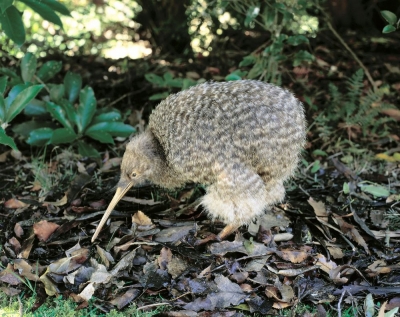
The kiwi from New Zealand has nostrils at the tip of its beak. It sniffs out insects and worms and then pecks them out of the earth with its long beak.
Kiwi are omnivorous and although worms form a major part of their diet, they will also readily eat woodlice, millipedes, centipedes, slugs, snails, spiders, insects, seeds, berries and plant material. Kiwi feed at night and probe into the ground with their bill up to a depth of 12cm.
Big ear openings provide a very good sense of hearing and the long graceful whiskers and sensitive bill help it locate food in the soil and leaf litter. Kiwi chicks are instinctive feeders and are not taught by parent birds to forage for food.
Stoats, ferrets and weasels are the biggest threat to the survival of Kiwi, closely followed by cats and dogs – only 5% of all Kiwis hatched in the wild survive to adulthood. The feather patterns allow kiwi to protect themselves by disappearing into the dark and fading into the forest vegetation. When distressed a kiwi freezes, disguising itself from aerial predators.
The kiwi is often given away by the sound of its uniquely placed ‘noisy’ nostrils at the tip of its bill. As it walks it taps the ground with its bill, probing the soil and sniffing loudly.
Credit : Rainbow Springs
Picture Credit : Google




